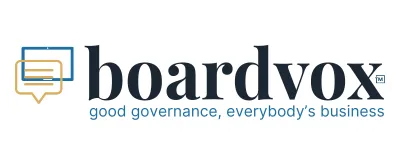
Embodying
The Voice, Expression, and Tone
of Good Governance.

How Do You Know If Your Board Is Serious About Accountability
Good governance, everybody's business.
The test of accountability is not in what your board says but in how it behaves.
You see it in the room when roles are clear, questions are asked, and decisions are owned ...and you see its absence when ambiguity, silence, and drift take over.
In this article, I want to share three things with you:
Why accountability is central to good governance.
How accountability shows up in practice.
What your board can do to strengthen accountability.
A. Why accountability matters
Accountability is not an add on to how your board operates.
Every decision your board makes reaches further than the room you sit in. It reaches employees who depend on steady jobs, investors who trust you with their capital, customers who rely on your products and services, and communities that feel the effects of your choices.
None of them have a seat at your table, yet they all live with the consequences of how you carry out your oversight and how management supports you. That is why accountability cannot be treated as a formality.
If it is not built into the culture, its absence manifests quickly and consistently in:
missed responsibilities,
unchallenged assumptions, and
decisions no one owns.
Accountability is the discipline that ensures the authority you hold is carried out with fairness, transparency, and responsibility.
B. How accountability shows up
I. When accountability is weak
When the implications of accountability are ignored, the pattern is easy to spot.
First, ambiguity wins. No one knows who owns what, so issues remain hidden.
Then challenge weakens. Smart people hold back and groupthink takes over.
And evidently the signal gets noisy. Updates drag on, asks are unclear, and decisions become slow or poor.
Once that cycle sets in, the signs will show up around your board table: blurred lines between board and management, conflicts managed off the record, and “next time” becoming a habit.
And let's not forget that we get what we tolerate.
II. When accountability is strong
Strong accountability is about ownership, fairness, and trust, and not blame. It manifests as:
Clear ownership. Everyone at the table knows their role, understands their duties, and accepts the consequences of their decisions.
Active challenge. Directors asking hard questions and management responding with openness. Debate is welcomed, not avoided, because it sharpens oversight.
Visible follow-through. Decisions are recorded, tracked, and revisited. Successes are acknowledged, shortfalls are addressed, and commitments do not quietly disappear.
Strong accountability represents a board culture where clarity replaces ambiguity, discipline replaces drift, and trust replaces doubt.
C. How to strengthen accountability
Global governance codes consistently emphasize these anchors that follow. If your board adopts them, you will bake accountability into daily practice rather than leave it to chance:
1. Clarity of roles and duties
Codify powers, duties, and boundaries.
Use formal charters and role descriptions so everyone knows who owns what.
Adopt a clear delegation of authority framework so it is always clear who decides what and which matters are reserved for the board.
2. Board composition and independence
Ensure independence so directors can challenge management without fear of reprisal.
Refresh regularly with term limits to prevent boards becoming too insular.
Prioritize diversity of skills and perspectives. Homogeneity fuels groupthink and weakens oversight.
3. Oversight with rigor
Tie risk to strategy.
Define success measures and track against them.
Require dashboards or Key Risk Indicators aligned with strategy.
4. Measuring performance and consequences
Define how success will be assessed.
Use periodic reviews against KPIs.
Clarify consequences, both positive and negative, so accountability cuts both ways.
5. Structured reporting and updates
Use consistent formats and timelines to avoid drift.
Keep briefs concise and asks clear.
Embed accountability into the agenda. Each item should state what is needed: a decision, endorsement, or information.
6. Culture of questioning and transparency
Encourage candor and make room for hard questions.
Avoid rubber-stamping. Boards that engage in real debate perform better.
Build psychological safety so directors know they can raise concerns without risk of being sidelined.
7. Ongoing education and development
Ensure directors receive continuous professional development to stay informed on governance trends, regulations, and industry issues.
Provide joint education sessions with management to strengthen mutual understanding and alignment.
Link training to board evaluations so identified gaps translate into targeted development.
8. Regular evaluation and feedback loops
Evaluate the board, its committees, and individual directors.
Act on evaluation results. Do not let them become box-ticking rituals.
Use external facilitation periodically to surface blind spots and ensure the process is credible.
These practices do not just strengthen accountability. They shape the culture of your board, and that culture determines whether clarity and discipline prevail or ambiguity takes over.
D. In Closing ...Building a culture of accountability
If there is one thing to carry forward, it is this: accountability is not a side issue, it is the culture of your board in action. And as you think about your board’s appetite for accountability, consider these three points:
Clarity matters. Everyone at the table must know their role, their responsibilities, and the consequences that follow. Without clarity, accountability cannot take root.
Challenge strengthens oversight. A culture where directors ask tough questions and expect honest answers is a culture where accountability thrives.
Follow-through is the proof. Accountability is not measured by intent but by what gets decided, what gets done, and what gets addressed when commitments fall short.
The appetite for accountability is revealed not in what your board says, but in how you show up at each and every meeting.
Bold Leadership. Ethical Governance. Meaningful Impact. That's the charge. Carry it Forward!
Enjoyed this article? Subscribe to never miss an issue.
Drop me a note and share your best board leadership stories.
Stay tuned for more perspectives on bold leadership, ethical governance and meaningful impact insights. And if you haven't already, be sure to subscribe so you never miss a post. Together, we're set to build better boards and build boards better by reshaping the landscape of boardroom leadership, one director at a time.
🌐💼 #BecomeBoardReady #strategy #BoardDevelopment #CorporateGovernance #GoodGovernance #BoldLeadership #EthicalGovernance #BoardPerformance #boardvox 🤝🔍
Know someone who might be interested in this blog? Please be sure to share it with them.
Also be sure to follow our boardVOX WhatsApp channel here. It is Especially for directors, c-suite leaders, corporate secretaries and all interested in good governance.
Good Governance
At Your Fingertips
Subscribe to our list to get the best tips and insights on
how to be at your best in the boardroom!

